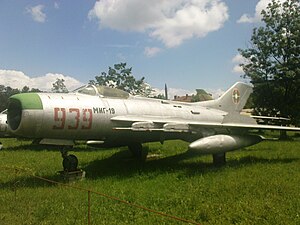Mikoyan-Gurevich MiG-19
| MiG-19 | |
|---|---|
 |
|
| Role | Fighter |
| Manufacturer | Mikoyan-Gurevich OKB |
| First flight | 27 May 1952 |
| Introduction | March 1955 |
| Status | In service with DPRK Air Force |
| Primary users |
Soviet Air Force People's Liberation Army Air Force |
| Number built | 2,172 (excluding production in China) |
| Variants |
Shenyang J-6 Nanchang Q-5 |
The Mikoyan-Gurevich MiG-19 (Russian: Микоян и Гуревич МиГ-19) (NATO reporting name: "Farmer") is a Soviet second-generation, single-seat, twin jet-engined fighter aircraft. It was the first Soviet production aircraft capable of supersonic speeds in level flight. A comparable U.S. "Century Series" fighter was the North American F-100 Super Sabre, although the MiG-19 would primarily oppose the more modern McDonnell Douglas F-4 Phantom II and Republic F-105 Thunderchief over North Vietnam.
On 20 April 1951, OKB-155 was given the order to develop the MiG-17 into a new fighter called "I-340", which was to be powered by two Mikulin AM-5 non-after-burning jet engines (a scaled-down version of the Mikulin AM-3) delivering 19.6 kN (4,400 lbf) of thrust. The I-340 was supposed to attain 1,160 km/h (630 kn; 720 mph) (Mach 1) at 2,000 m (6,600 ft), 1,090 km/h (590 kn; 680 mph) (Mach 0.97) at 10,000 m (33,000 ft), climb to 10,000 m (33,000 ft) in 2.9 minutes, and have a service ceiling of no less than 17,500 m (57,400 ft). The new fighter, internally designated "SM-1", was designed around the "SI-02" airframe (a MiG-17 prototype) modified to accept two engines in a side-by-side arrangement and was completed in March 1952.
The I-340 suffered from poor cockpit pressurization and the engines proved temperamental with frequent flameouts and surges with rapid throttle movements. The engines were upgraded to the AM-5A standard delivering 21.1 kN (4,700 lbf) of thrust each, which exceeded the power output of the Klimov VK-1F in afterburner while providing better fuel economy. The SM-1 was barely supersonic, reaching 1,193 km/h (644 kn; 741 mph) at 5,000 m (16,000 ft) (Mach 1.03). This performance was deemed insufficient for the new supersonic fighter and an after-burning version of the engine, the AM-5F, was proposed. While not implemented, the AM-5F served as the basis for the Tumansky RD-9 which powered production aircraft. Further development of the twin-engine concept resulted in a government request for the "I-360", internally designated "SM-2", powered by the AM-5F engines, but featured a highly swept wing.
...
Wikipedia
